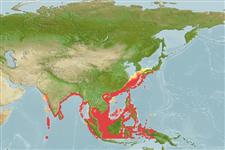Common names from other countries
>
Scombriformes (Mackerels) >
Scombridae (Mackerels, tunas, bonitos) > Scombrinae
Etymology: Scomberomorus: Latin, scomber = mackerel + Greek, moros = silly, stupid (Ref. 45335).
Environment: milieu / climate zone / depth range / distribution range
Ekologi
laut; oceanodromus (Ref. 51243). Tropical; 39°N - 6°S, 70°E - 138°E (Ref. 168)
Indo-West Pacific: west coast of India and Sri Lanka along the continental shelf eastward to Sumatra, Indonesia and Singapore, and northward to China, Korea (Ref. 9684) and Wakasa Bay, Sea of Japan. Does not extend past Sumatra in the East Indies (Ref. 9684).
Length at first maturity / Size / Weight / umur
Maturity: Lm ?, range 75 - ? cm
Max length : 150 cm FL jantan/; (Ref. 168); common length : 60.0 cm FL jantan/; (Ref. 168); Berat maksimum terpublikasi: 15.0 kg (Ref. 168)
Duri punggung (Keseluruhan (total)) : 14 - 17; duri punggung lunak (Keseluruhan (total)) : 20 - 24; Duri dubur: 0; Sirip dubur lunak: 20 - 24; vertebrata, bertulang belakang: 46 - 47. Interpelvic process small and bifid. Lateral line with many auxiliary branches extending dorsally and ventrally in anterior third, gradually curving down toward caudal peduncle. Intestine with 4 folds and 5 limbs. Swim bladder absent. Body covered with small scales. Sides silvery with spots scattered along lateral median line.
Feeds on small schooling fishes, such as sardines and anchovies and on shrimps. This species makes up an important part of the drift net fishery in Palk Bay and the Gulf of Mannar. Marketed fresh and dried-salted (Ref. 9684).
Collette, B.B. and C.E. Nauen, 1983. FAO Species Catalogue. Vol. 2. Scombrids of the world. An annotated and illustrated catalogue of tunas, mackerels, bonitos and related species known to date. Rome: FAO. FAO Fish. Synop. 125(2):137 p. (Ref. 168)
Status IUCN Red List (Ref. 130435)
CITES (Ref. 128078)
Not Evaluated
ancaman kepada manusia
Harmless
penggunaan manusia
Perikanan: nilai komersial kecil; Ikan buruan: ya
Alat, peralatan
laporan khas
muat turun XML
Sumber internet
Estimates based on models
Preferred temperature (Ref.
115969): 20.1 - 28.6, mean 27.3 (based on 823 cells).
Phylogenetic diversity index (Ref.
82804): PD
50 = 0.5000 [Uniqueness, from 0.5 = low to 2.0 = high].
Bayesian length-weight: a=0.00832 (0.00383 - 0.01808), b=3.03 (2.86 - 3.20), in cm Total Length, based on LWR estimates for this Genus-body shape (Ref.
93245).
Trophic level (Ref.
69278): 4.2 ±0.74 se; based on food items.
Daya lenting (Ref.
120179): sedang, Waktu penggandaan populasi minimum 1.4 - 4.4 tahun (Preliminary K or Fecundity.).
Fishing Vulnerability (Ref.
59153): Very high vulnerability (90 of 100).
